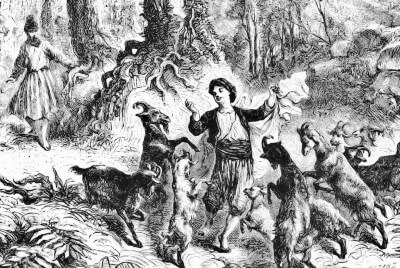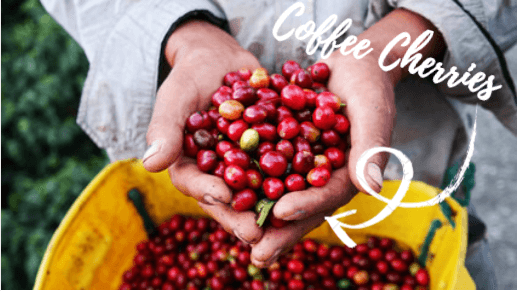“Howdy… Howdy…
Cinchona Coffee talking. I don’t know if we’ve met yet. I’m kind of a staple here at Collin Street Bakery. If you haven’t heard of me, it’s probably because I share a shelf with the big man of the bakery, the DeLuxe Fruitcake. You know, sharing a shelf with the Chief himself means I usually get overlooked. The fact is he’s a legend and deserves the hype; for being 122 years old, the DeLuxe® is looking amazing!
That being said, you could understand when I was asked to write a little something about myself, I couldn’t pass on the opportunity. This was my time to be a star! So here we are!
Here’s the deal, most of you have enjoyed a cup of coffee today. Perhaps you are even reading my article right now while sipping a hot cup of java. But how much do you actually know about coffee? How does the coffee grown in say… a remote part of Costa Rica, get from crop to cup?
That’s what I want to share with you today: the journey of coffee from bean to brew.
Caution: Hot Coffee Facts!
#1 – Origin Of Coffee
Kaldi The Goat Herder
The origin of coffee is traced back to the Kaffa region of Ethiopia and North Africa. The legend of the discovery of coffee is said to be set in an ancient coffee forest on the Ethiopian plateau. A goat herder, named Kaldi, first discovered the coffee’s energizing capabilities when his goats became so hyper after eating the beans, they couldn’t sleep for the entire night. After reporting his findings to an Abbott and a local monastery, the Abbott became curious and went in search of the beans. Making a drink from beans, he recounted his ability to stay alert through long hours of evening prayer.

After sharing his experience with others, word of the beans capabilities spread and thus the world’s obsession with coffee was born.
#2 -The Coffee Family
There are some odd 100 species within the Coffea genus. These species of coffee are cultivated in more than 70 countries, mostly located in the equatorial regions of Central and South America, Africa and Southeast Asia.

#3 – Arabica or Robusta?
These 100 different species of coffee can be classified primarily in two categories: Coffea Arabica or Coffea Robusta. Arabica beans produce a better tasting coffee having twice the concentration of sugar than Robusta. Collin Street Bakery’s Cinchona Coffee (that’s me, remember!) is made from a 100% Arabica coffee beans.
#4 – From Plant to Bean
Coffee plants produce either white or red berries which are called “cherries.” These cherries contain the actual coffee seed otherwise known as beans. Most coffee berries contain two seeds. However, a very small subset of berries only produce one seed; these single seeds are known as “peaberries.”
#5 – Geographic Location
Coffee and wine share a lot of similarities. Just how the geographic location of a vineyard can yield a grape with a specific set of characteristics, so can the location of a coffee field. The attributes of the specific climate and region in which coffee is grown, such as elevation, sun exposure, and rainfall, can have impactful effects on the palatable qualities of coffee.

FOR EXAMPLE,
I am grown high on a mountain in Costa Rica where the elevation is roughly 4,000 feet (~1,220 meters). Coffee plants grown at this elevation tend to produce higher density, less porous beans. These beans are considered more desirable because of their ability to withstand a longer roasting process.
#6 – Roasting Standards
Dense beans can be roasted much longer producing coffees with a much darker flavor profile such as espressos and French roasts. Depending on the porosity and density of coffee bean is roasted, a batch of coffee can weight 10 – 20% less while nearly doubling in volume after being roasting.

#7 – A Refined Palette
Having similar indicators as wine, such as aroma, body, flavor, and complexity, some coffee experts believe good coffee can be as complex and nuanced as fine wine.
Take for example my flavor profile and that of most Costa Rican coffees:
Aroma: Intense, Fragrant, Brown Sugar
Body: Round
Flavor: Citrus, Tropical Fruit, Apricot
Acidity: Lively, Bright


Bonus Facts!
A wine expert is called a ‘sommelier’ and they ‘taste’ wine. A coffee expert is called a ‘coffee sommelier’ and they ‘cup’ coffee.
The Dregs, Dreg [N]: the sediment of coffee left at the bottom of the cup once it’s been consumed. Synonym: The End.
So now you know a little bit more about coffee and a little more about me specifically. You remember me right? I’m Cinchona coffee and the one narrating this educational blog. Has your brain drifted back to fruitcake so quickly?!
Well, I knew I couldn’t be the star forever. Ce la vie!
